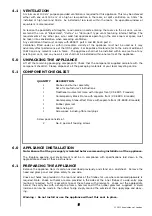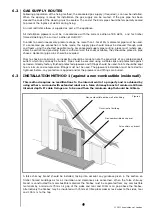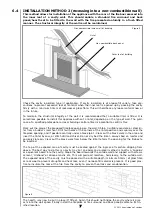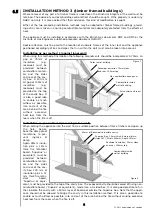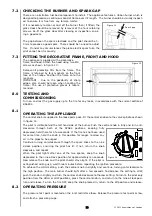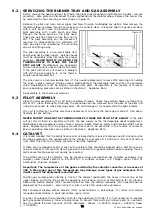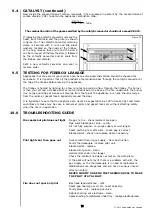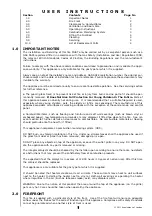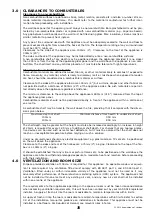
APPLIANCE DATA
INSTALLATION REQUIREMENTS
The fire has been designed to be installed in two main applications; either to fit into a suitable opening
created in the inner leaf of an outside wall or false chimney breast/extended fire surround built to con-
ceal the appliance. The appliance can also be fitted into an unserviceable or inoperative fireplace served
by a natural draught flue but the old flue must be sealed off. It will be necessary to ventilate the old
flue to prevent condensation and dampness forming, however any air vent used to ventilate the old flue
must not be sited within 500mm of this appliance. If the flue can be ventilated to the outside of the
building then this is usually the best solution. If in doubt then advice should be sought from a local
building control officer.
The appliance must be installed onto a suitable non-combustible insulating surface at least 12 mm thick
covering the entire base area of the box. The fire must be used with a back panel capable of with-
standing 150°C minimum. Any combustible materials directly behind the fire frame (or back panel) and
close to the cavity box of the fire must be removed and replaced with non-combustible material such
as cement, browning, 'Superlux' board or equivalent materials.
ROOM SIZING
The room size should be a minimum of 27m
3
(e.g. 11’ x 11’ x 8’) to allow adequate circulation of air
and ensure the correct operation of the fire. This volume may include adjacent spaces but these spaces
must not be separated by a door. To calculate a room size in cubic metres (m
3
) divide the room volume
in cubic feet (ft
3
) by 35.3.
SITE REQUIREMENTS
This appliance may be installed in any room in the home except bathrooms. If the appliance is to be
fitted in a bedroom then an electronic carbon monoxide detector complying with the current edition of
BSEN 50291 must be installed in the same room as the appliance. For maximum safety it is recom-
mended that such device is continuously (mains) powered and arranged in such a way that the gas sup-
ply to the appliance is isolated in the event of an alarm. The selection and installation of such device
shall be in accordance with the current edition of BSEN 50292, and the user must be briefed regarding
the use and maintenance of such a device. Installation in living rooms is common, however other rooms
such as kitchens, dining rooms and hallways are permitted, providing a suitable gas supply is available,
and rooms sizing and ventilation requirements are strictly adhered to (see sections 3.1 and 4.1).
The appliance is designed to be versatile, and as such will operate correctly when exposed to normal
gentle draughts experienced within the home. It is not recommended, however that the appliance be
installed in areas where it is likely to be directly exposed to persistent strong draughts, that may be
generated by outside doors, windows, air vents, air conditioning units, extractor fans, ceiling fans etc.
See section 4.1 for more information on ventilation.
Gas Group
Inlet Pressure (± 2.0mbar)
Regulator Pressure
Max Energy Input (Gross)
Max Energy Input (Net)
Max Gas Rate
Min Energy Input (Gross)
Min Energy Input (Net)
Min Energy Input (Gross)
Min Energy Input (Net)
Operating Pressure (±2.0 mbar)
Flow restrictor orifice
Injector
Oxypilot (SIT/Bray)
Gas control
Gas Inlet restrictor elbow
Ignition
Spark Gap
X-ERO
G20 Natural Gas CAT I2H
20 mbar
N/A
2.3 kW
2.07 kW
0.23 m3/h
1.3 kW
1.17 kW
166 W
150 W
20 mbar
1.09 mm
N/A
9110
Copreci 21400 series
8mm
Double piezo spark
3.5-4.5 mm
2.0
3.0
3.1
4.0
2
©
2011 Acquisitions of London
Please see Data Badge affixed to appliance for current data.
This appliance is for use only with the gas type, and at the pressure stated on the appliance Data Badge.







